 W
WAelred of Rievaulx ; also Ailred, Ælred, and Æthelred; was an English Cistercian monk, abbot of Rievaulx from 1147 until his death, and known as a writer. He is regarded by Anglicans and Catholics as a saint.
 W
WAngelos Akotantos was a 15th-century Byzantine-Cretan Icon-painter and hagiographer who lived and worked at Heraklion, Crete, then part of the Republic of Venice. He was the first hagiographer to sign his name on his icons by writing in Greek: "Χειρ Αγγέλου" which, translated in English, means "By hand of Angelos".
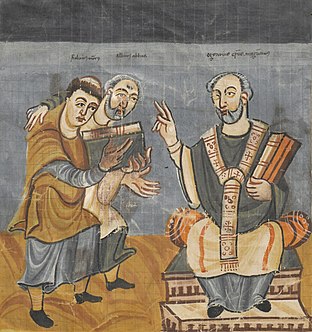 W
WAlcuin of York – also called Ealhwine, Alhwin, or Alchoin – was an English scholar, clergyman, poet, and teacher from York, Northumbria. He was born around 735 and became the student of Archbishop Ecgbert at York. At the invitation of Charlemagne, he became a leading scholar and teacher at the Carolingian court, where he remained a figure in the 780s and 790s. During this period, he perfected Carolingian minuscule, an easily read manuscript hand using a mixture of upper- and lower-case letters. Latin paleography in the eighth century leaves little room for a single origin of the script, and sources contradict his importance as no proof has been found of his direct involvement in the creation of the script. Carolingian minuscule was already in use before Alcuin arrived in Francia. Most likely he was responsible for copying and preserving the script while at the same time restoring the purity of the form.
 W
WBede, also known as Saint Bede, the Venerable Bede, and Bede the Venerable, was an English Benedictine monk at the monastery of St. Peter and its companion monastery of St. Paul in the Kingdom of Northumbria of the Angles.
 W
WJean Bolland was a Jesuit priest and prominent Flemish hagiographer.
 W
WThe Bollandists or Bollandist Society are an association of scholars, philologists, and historians who since the early seventeenth century have studied hagiography and the cult of the saints in Christianity. Their most important publication has been the Acta Sanctorum. They are named after the Flemish Jesuit Jean Bolland or Bollandus (1596–1665).
 W
WCaesarius of Heisterbach, sometimes erroneously called, in English, Caesar of Heisterbach, was the prior of a Cistercian monastery, Heisterbach Abbey, which was located in the Siebengebirge, near the small town of Oberdollendorf, Germany.
 W
WJohn Canaparius was a Benedictine monk at the Aventine monastery in Rome. It had been long assumed that in the year 999 he wrote the first Vita sancti Adalberti episcopi Pragensis, or "Life of St. Adalbert of Prague" just two years after Adalbert's death.
 W
WJohn Colgan, O.F.M., was an Irish Franciscan friar noted as a hagiographer and historian.
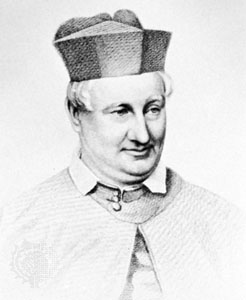 W
WFr. Frederick William Faber C.O. was a noted English hymn writer and theologian, who converted from Anglicanism to Roman Catholicism in 1845. He was ordained to the Catholic priesthood subsequently in 1847. His best-known work is Faith of Our Fathers.
 W
WFilippo Ferrari was an Italian Servite monk and scholar, known as a geographer, and also noted as a hagiographer.
 W
WGerald of Wales was a Cambro-Norman archdeacon of Brecon and historian. As a royal clerk to the king and two archbishops, he travelled widely and wrote extensively. He studied and taught in France and visited Rome several times, meeting the Pope. He was nominated for several bishoprics but turned them down in the hope of becoming Bishop of St Davids, but was unsuccessful despite considerable support. His final post was as Archdeacon of Brecon, from which he retired to academic study for the remainder of his life. Much of his writing survives.
 W
WGodfrey Henschen, 21 June 1601 – 11 September 1681, was a Belgian Jesuit hagiographer, one of the first Bollandists.
 W
WBorn in Gandersheim to Saxon nobles Hrotsvitha was a German secular canoness, who wrote dramas and poems during the rule of the Ottonian dynasty. Hrotsvitha lived at Gandersheim Abbey. She is considered the first female writer from the German Lands, the first female historian, the first person since antiquity to write dramas in the Latin West, and the first female poetess in Germany.
 W
WJerome, also known as Jerome of Stridon, was a Latin priest, confessor, theologian, and historian; he is commonly known as Saint Jerome.
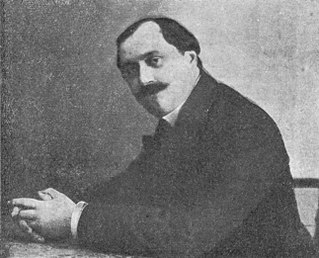 W
WDumitru or Dimitrie Karnabatt was a Romanian poet, art critic and political journalist, one of the minor representatives of Symbolism. He was a disciple of both Alexandru Macedonski and Ștefan Petică, representing the conservative and mystical school of Romanian Symbolism, and a regular contributor to the newspaper Seara. He is also remembered as the husband and, for a while, literary partner of novelist Lucrezzia Karnabatt.
 W
WLuca Cancellari is a Byzantine icon painter posited in some modern Greek encyclopaedias to have lived during the 12th century in Constantinople, where he painted some of the best icons of Virgin Mary. These works ascribe him the creation of icons like the Madonna Nicopeia in St Mark's Basilica, that ended up in Venice after the conquest of Constantinople by the Crusaders in 1204, the Madonna di San Luca in the namesake Sanctuary, transferred in Bologna in 1160 and bearing the inscription Opus Lucae Cancellari, or as read by Antonio Masini (1599-1691) Cancellarii, the Madonna Salus Populi Romani in the Basilica di Santa Maria Maggiore in Rome and other with Greek inscriptions of that period.
 W
WUdriște Năsturel, first name also Uriil, Uril, Ioriste, or Oreste, last name also Năsturelovici, was a Wallachian scholar, poet, and statesman, the brother-in-law of Prince Matei Basarab through his sister Elena Năsturel. Together, the three staged a cultural revival centered on Bucharest and Târgoviște. Năsturel had risen through the ranks of Wallachian bureaucracy and had served Radu Mihnea's government in Moldavia, being kept as Logothete by Matei Basarab. In office, he had an international correspondence and went on diplomatic travels through Central Europe, while also overseeing the printing presses. He was the titular boyar of Herăști, known in his day as Fierești and Fierăști, where he built a palace that stands as a late example of Renaissance architecture, and earned him a regional fame.
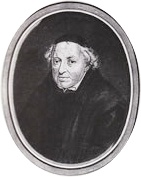 W
WDaniel Papebroch, S.J., was a Flemish Jesuit hagiographer, one of the Bollandists. He was a leading revisionist figure, bringing historical criticism to bear on traditions of saints of the Catholic Church.
 W
WPetrus de Dacia was a 13th-century Swedish monk of the Dominican Order. He was most noted for his correspondence with the mystic and ecstatic Christina von Stommeln. Though he wrote in Latin, Petrus de Dacia is often credited as the first author in Sweden.
 W
WJustin Popović was a Serbian Eastern Orthodox theologian, archimandrite of the Ćelije Monastery, Dostoyevsky scholar, writer, an advocate of anti-communism and a critic of the pragmatic church ecclesiastical life.
 W
WReginald of Durham was a Benedictine monk and hagiologist, a member of the Durham Priory and associated with the Coldingham Priory.
 W
WPedro de Ribadeneira S.J. was a Spanish hagiographer, Jesuit priest, companion of Ignatius of Loyola, and a Spanish Golden Age ascetic writer.
 W
WRobert of Shrewsbury or Robertus Salopiensis was a Benedictine monk, prior and later abbot of Shrewsbury Abbey, and a noted hagiographer.
 W
WSaint Sava, known as the Enlightener, was a Serbian prince and Orthodox monk, the first Archbishop of the autocephalous Serbian Church, the founder of Serbian law, and a diplomat. Sava, born as Rastko, was the youngest son of Serbian Grand Prince Stefan Nemanja, and ruled the appanage of Hum briefly in 1190–92. He then left for Mount Athos, where he became a monk with the name Sava (Sabbas). At Athos he established the monastery of Hilandar, which became one of the most important cultural and religious centres of the Serbian people. In 1219 the Patriarchate exiled in Nicea recognized him as the first Serbian Archbishop, and in the same year he authored the oldest known constitution of Serbia, the Zakonopravilo nomocanon, thus securing full independence; both religious and political. Sava is regarded as the founder of Serbian medieval literature.
 W
WPiotr Skarga was a Polish Jesuit, preacher, hagiographer, polemicist, and leading figure of the Counter-Reformation in the Polish–Lithuanian Commonwealth. Due to his oratorical gifts, he has been called "the Polish Bossuet".
 W
WLaurentius Surius was a German Carthusian hagiographer and church historian.
 W
WSymeon the Metaphrast was the author of the 10-volume medieval Greek menologion, or collection of saints' lives. He lived in the second half of the 10th century. About his life we know only very few details.
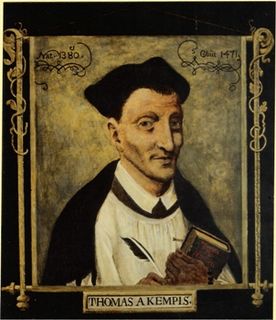 W
WThomas à Kempis was a German-Dutch canon regular of the late medieval period and the author of The Imitation of Christ, one of the most popular and best known Christian devotional books. His name means "Thomas of Kempen", Kempen being his home town.
 W
WJacob of Tsurtavi also known as Jacob the Priest was the 5th-century Georgian religious writer and priest from Tsurtavi, then the major town of Gogarene and the Lower Iberia.
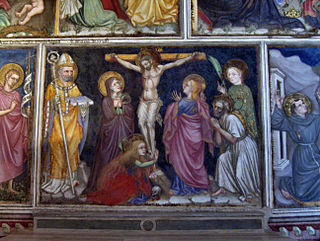 W
WJacopo De Fazio, best known as the blessed Jacobus de Varagine, or in Latin Voragine was an Italian chronicler and archbishop of Genoa. He was the author, or more accurately the compiler, of Legenda Aurea, the Golden Legend, a collection of the legendary lives of the greater saints of the medieval church that was one of the most popular religious works of the Middle Ages.
 W
WNikolaj Velimirović was bishop of the eparchies of Ohrid and Žiča (1920–1956) in the Serbian Orthodox Church. An influential theological writer and a highly gifted orator, he was often referred to as the new John Chrysostom and historian Slobodan G. Markovich calls him "one of the most influential bishops of the Serbian Orthodox Church in the twentieth century"